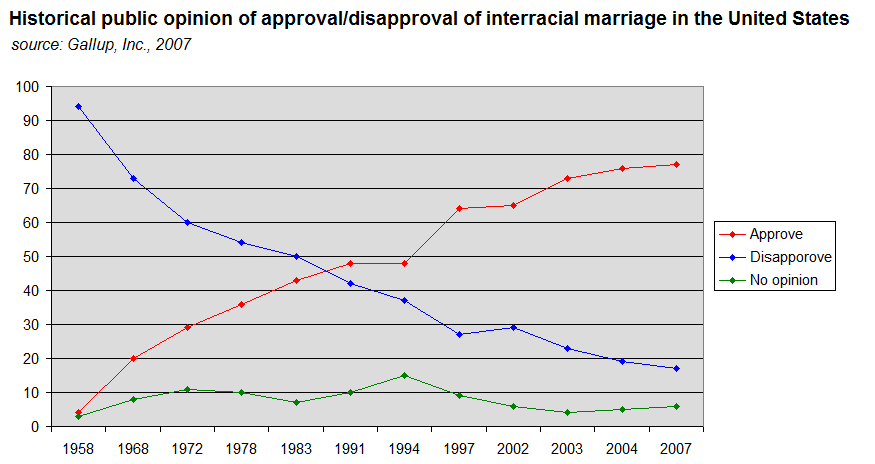Individuals reflect on their experiences as interracial children
February 23, 2016
photo via wikipedia.org under Creative Commons license
Chart describing the public opinion of interracial marriage in the U.S. and whether individuals disagree or approve throughout years.
Sophomore Nathalia Isagholian, the daughter of an Armenian father and Brazilian mother, says she is so thankful to have parents of different races. It creates diversity in her life and makes her feel like she belongs with both races. “It helped me learn a lot about different cultures, and I believe it has ultimately made me a more understanding person,” Isagholian said.
Isagholian said that she has learned that race should never define a person, and that being open-minded and friendly to individuals of any ethnicity is important. “The only thing I would want to change is my lack of interest in my Armenian side when I was younger,” Isagholian said. “I did not want to learn Armenian because I knew Portuguese. I thought it was unnecessary, but this is my biggest regret. However, now I am trying to be a part of both sides as best I can.”
Over the past few years, the rate of biracial marriage in the United States has shown a steady increase. According to the Pew Research Center, about 15 percent of all new marriages in the United States during 2010 were between spouses of a different race or ethnicity from one another, more than double in 1980. While 41 percent agree that interracial marriage has been a change for the better in our society, 11 percent say it has been a change for the worse, and the other 44 percent say it has not made a difference whatsoever.
Although the divorce rates for people who marry an individual of a different race are higher than individuals who marry the same race, several studies using government data showed that the statistics vary by race and gender.
Junior Jacquelyn Goryan is the daughter of a Mexican mother and Armenian father. “I get a taste of both of their ethnicities and heritages,” Goryan said. “I’ve had so many remarkable experiences and have been in so many unique situations because of both of the nationalities I come from. Some people have a hard time understanding or accepting how I am from two different backgrounds, but it comes to show that the people who actually truly care for me learn to love and cherish the way I am.”
Along with interracial marriage comes unique memories. “The thing that warms my heart the most is when I see both sides of my family come together for a special occasion and get along, despite their different backgrounds,” Goryan said.
According to a new study published by the Brookings Institute, there has been a large increase in interracial relationships, specifically with Asians, Hispanics and Native Indians. Asian women were much more likely to marry a white or black man than Asian men. Also, it was found that black women marry an individual of another race less often than black men. Only nine percent date or marry white men, while 24 percent of black males end up with a white woman. For every state, there is an estimation as to how many interracial marriages exist. At the top of the list is California, with a total of 4.8 million.
Experts there say the constant flow of new Asian and Hispanic immigrants has expanded the variety of different raced spouses. In the past three decades, the number of interracial marriages has grown from 651,000 in 1981 to more than 2.4 million, according to U.S Census data. In order to count the number of interracial marriages, seven race groups are used; the white and African American category has grown from 167,000 to 558,000 since 1981.
According to studies by the National Institutes of Health, some ethnicities and cultural groups are more strict regarding marrying outside of one’s ethnicity or culture. Sophomore Maryam Jambazian says her parents would never allow her to be in a relationship with a man of a different race. “I think it is more difficult for me because I’m an Armenian,” Jambazian said. “My parents want me to preserve my culture and language, and they say if I marry a non-Armenian, it’s a sign of disrespect to my ancestors and family.”
Even though several cultures advocate same-race marriages, the United States gives individuals the right to marry their desired spouse, whether they are the same race or different. In fact, prior to 1987, marrying someone of a different race was considered a crime in some states. Mildred and Richard Loving, an interracial couple were arrested just for marrying another person of a different race. Finding out Mildred was pregnant, they both traveled to Washington, D.C. in order to avoid Virginia’s Racial Integrity Act.
During their return, both were found guilty and told, “as long as you live, you will be known as a felon.” In 1963, they both approached the American Civil Liberties union to fight their case in court. After a long legal battle, the Supreme Court said laws prohibiting marriage were unconstitutional. Finally, in 2000, the last law banning interracial marriage was repealed in Alabama.
